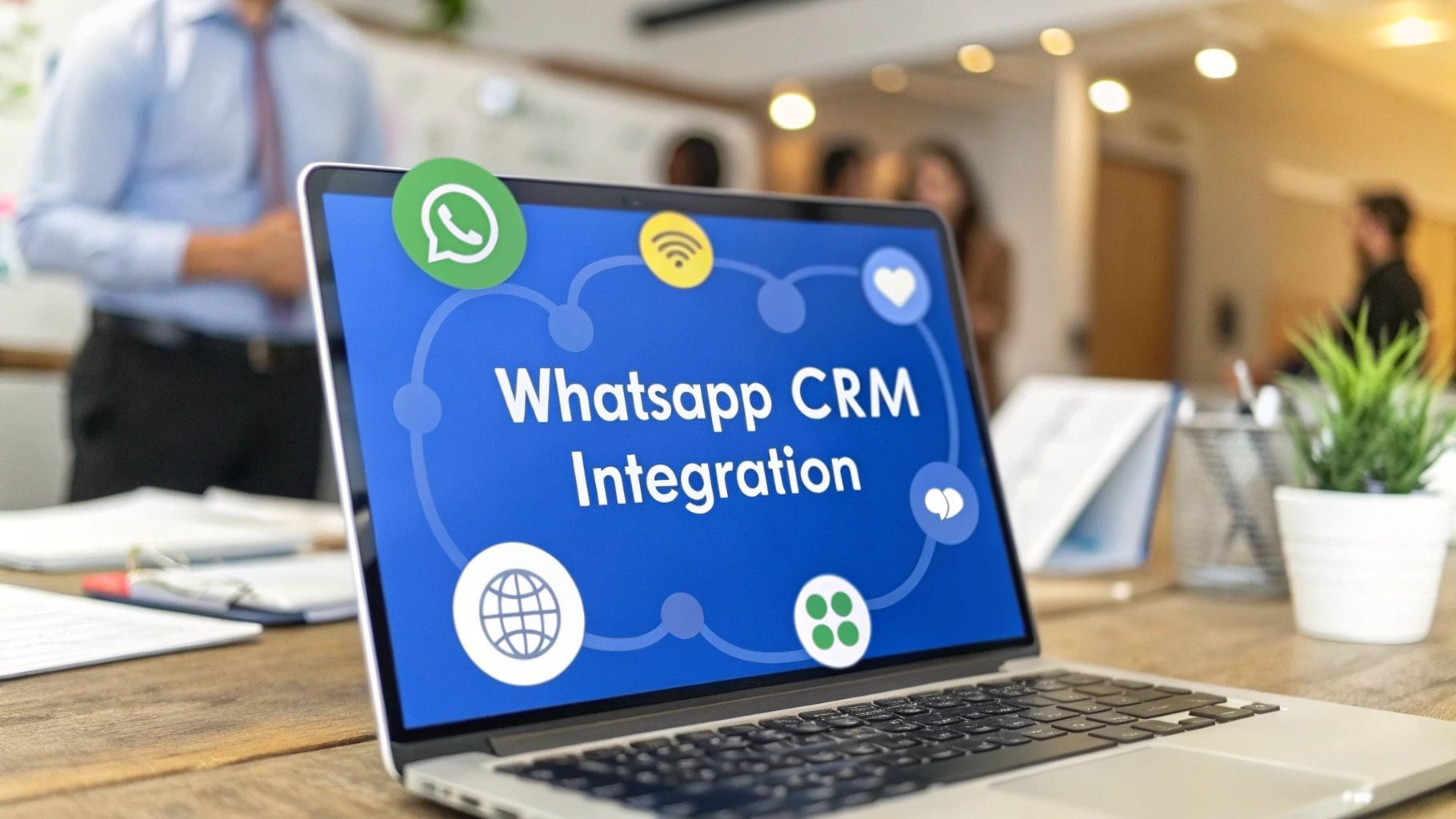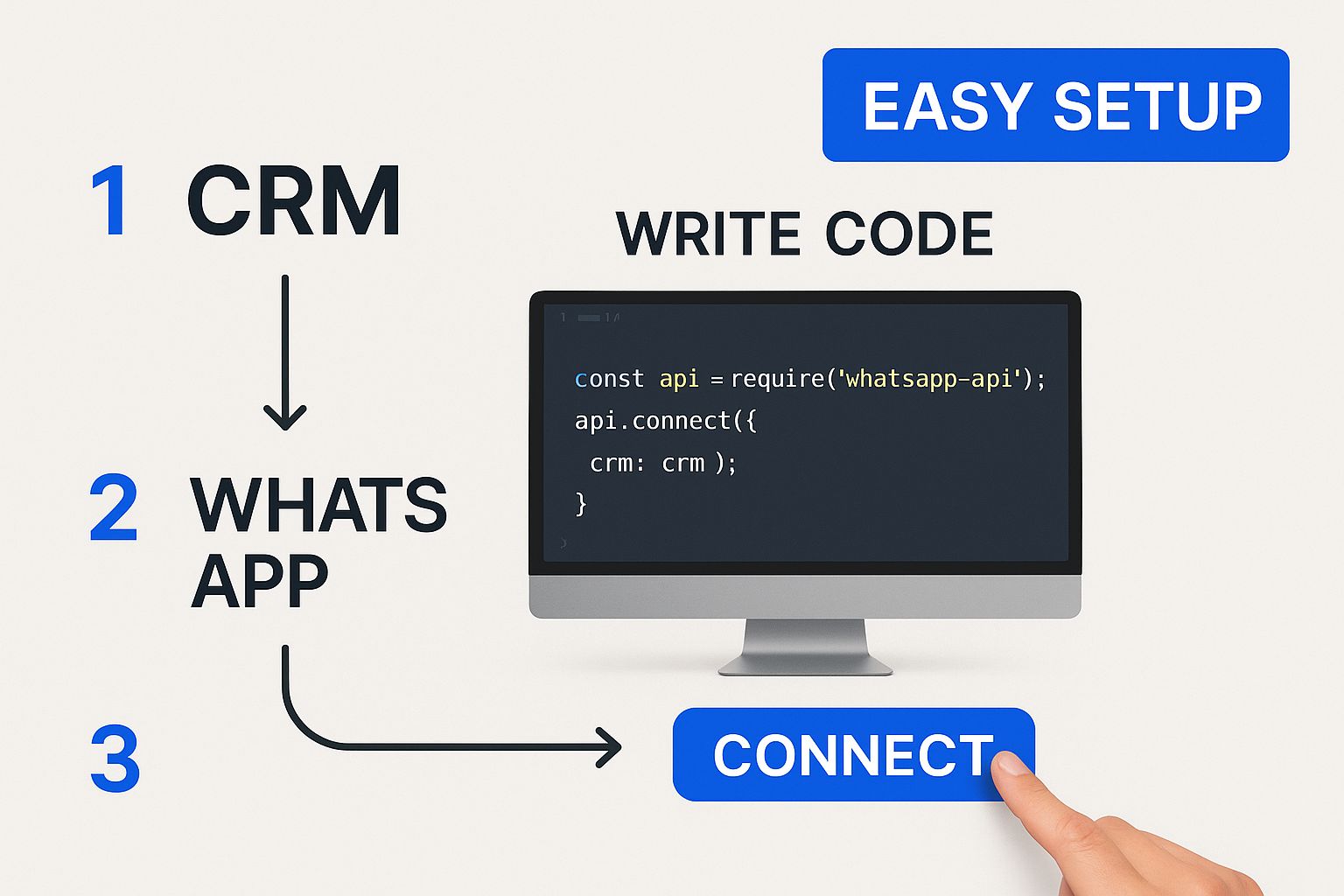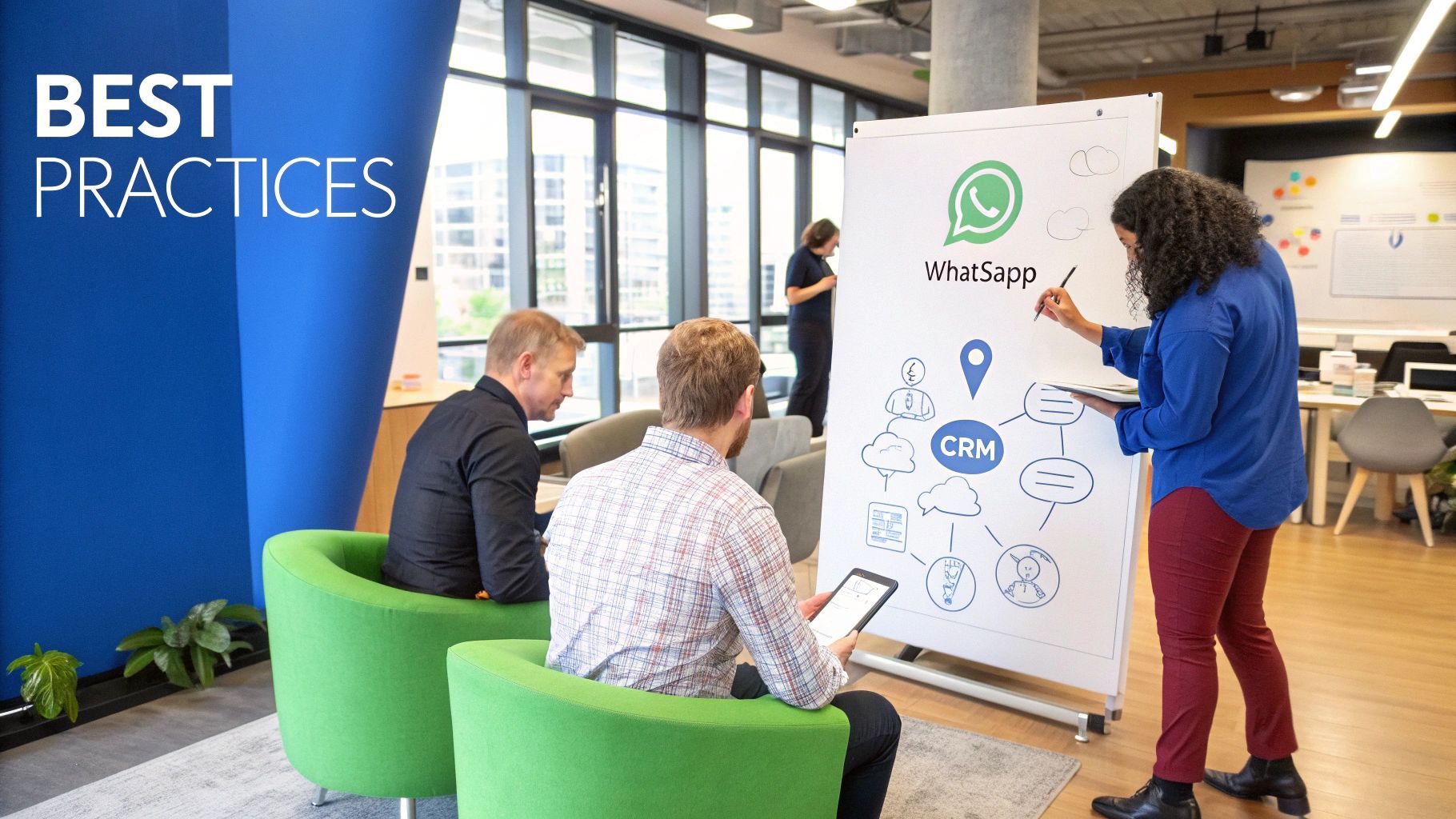
CRM WhatsApp Integration: Boost Customer Engagement
Discuss with AI
Get instant insights and ask questions about this topic with AI assistants.
💡 Pro tip: All options include context about this blog post. Feel free to modify the prompt to ask more specific questions!
Connecting your WhatsApp Business platform with a CRM system is one of the smartest moves you can make for your business. Simply put, this integration creates a single, unified command center. All your customer chats from WhatsApp are automatically funneled, logged, and organized right alongside every other piece of customer data in your CRM.
It gives you a complete, 360-degree view of every single interaction, which is a game-changer for any customer-facing team.
Let's be real: customers want to talk to you on the platforms they already use every day. For billions of people, that platform is WhatsApp. When your sales and support teams are jumping between different apps, you create chaos. Conversations get lost, response times drag on, and your team misses crucial context.
Integrating WhatsApp directly into your CRM isn't just a neat trick; it’s a core strategic decision. It turns those scattered, one-off chats into a valuable, organized asset.
Imagine this scenario: a support agent gets a WhatsApp message from a frustrated customer. Instead of starting from scratch, they instantly see the customer's entire purchase history and past support tickets right there on the screen. This context is gold. It allows for faster, smarter, and far more personal resolutions.
The biggest win here is establishing a single source of truth. Without an integration, a customer's journey is a mess. It might start on WhatsApp, jump to email, and finish with a phone call. The details are scattered everywhere, forcing the customer to repeat themselves and leaving your team feeling lost.
A proper integration brings it all together. Every message, no matter where it came from, gets logged neatly into the customer's CRM profile. This means seamless handoffs are finally possible. A sales rep can see a prospect’s recent support ticket, and a support agent can understand the customer's sales history, which creates a genuinely smooth experience for everyone.
When you meet customers on their turf, you eliminate friction. This simple convenience can become your biggest competitive advantage, building the kind of loyalty that brings people back again and again.
For sales teams, a CRM WhatsApp integration is an incredible lead-nurturing tool. You can finally chat with prospects in a direct, personal way that feels natural, not like a cold, intrusive phone call. Since everything is tracked, you can automate follow-ups, set reminders, and guide leads through your pipeline with far less manual effort.
Support teams, on the other hand, see a massive jump in their efficiency and effectiveness. Some of the immediate benefits I've seen teams experience are:
- Lightning-Fast Responses: WhatsApp messages land in the same queue as all other support channels. Nothing falls through the cracks.
- Truly Personal Service: With full customer data at their fingertips, agents can provide tailored solutions without asking the same old questions.
- Smarter Teamwork: Agents can easily assign conversations, leave private notes for colleagues, and escalate complex issues, all from within the CRM.
If you're still on the fence, just look at the data. WhatsApp's user base is projected to hit an astounding 3.2 billion by 2025, and more than 50 million businesses are already on the platform. It's not just a messaging app anymore; it's a primary channel for commerce and communication.
The engagement is off the charts. WhatsApp messages boast a nearly 98% open rate, which completely blows traditional email marketing out of the water. Tying this high-engagement channel into the very core of your business operations isn't just a nice-to-have. For any business serious about growth, it's essential. You can dive deeper into these global trends and their business implications over at WAPiKit.

A powerful CRM WhatsApp integration doesn’t just happen by clicking a “connect” button. From my experience, the real success is determined by the planning you do beforehand. Getting this foundation right ensures the technology works for you, not against you, from the very beginning. It all starts with making a few key decisions about your tools and goals.
Your first big choice is selecting the right WhatsApp Business tool. This decision has massive implications for how you can scale and what you can ultimately achieve.
For many small businesses, the free WhatsApp Business App is the first stop. It’s great for a single person or a tiny team managing a handful of chats on one phone. You get basic features like quick replies and a business profile, which is a solid start.
But when you need to grow, you’ll hit a wall. The app isn't built for team collaboration or automation, and it can't be properly integrated with a CRM.
This is where the WhatsApp Business API comes into play. The API is built for businesses that are serious about growth—handling higher message volumes, supporting multiple users, and automating communications. It's the engine that powers a true CRM integration, letting platforms like Spur plug WhatsApp conversations right into your workflow. With the API, you unlock advanced capabilities like chatbots, automated notifications, and multi-agent access, making it the only real choice for a serious integration project.
Once you’ve committed to the API, the next step is ensuring your core systems are ready. Understanding the fundamentals of a specialized Customer Relationship Management (CRM) system is crucial before you try to connect anything to it. Your CRM has to be able to support API connections, either on its own or through a third-party platform.
When you're looking at a third-party integration provider like Spur, here’s what I recommend you look at:
- Native Connection: Does it offer a direct, clean connection to your specific CRM, or does it feel like a clunky workaround? A native integration will save you headaches during setup and down the road.
- Feature Depth: Go beyond just logging messages. Can the platform handle automated workflows, message templates, and provide insightful reports?
- Reliability and Support: This platform will become a critical part of how you talk to customers. Check their uptime guarantees and see if you can get a real, knowledgeable person on the phone when you need help.
A common mistake I see is teams choosing a provider based on price alone. A cheap but unreliable integration will cost you far more in lost leads and frustrated customers than a robust, well-supported platform ever will.
With the right tools in your corner, you now need to define what success actually looks like. Integrating technology without clear objectives is like sailing without a map—sure, you’re moving, but you have no idea where you’re headed. Your goals need to be specific, measurable, and tied directly to real business outcomes.
Start by pinpointing your biggest frustrations. Are your support agents drowning in tickets and struggling with slow response times? Is your sales team letting promising leads slip through the cracks? These problems can be translated into clear, actionable goals for your integration.
Here are a few examples of strong, tangible goals:
Business Area Goal Key Metric to Track Customer Support Reduce first-response time for WhatsApp inquiries by 30%. Average First Response Time (FRT) Sales Increase lead conversion rate from WhatsApp by 15%. Lead-to-Customer Conversion Rate Customer Success Improve Customer Satisfaction (CSAT) score for support by 10 points. CSAT Score
Setting these targets does more than just justify the investment; it gives your team a clear sense of purpose. It turns a technical task into a strategic mission to improve how you do business.
For a deeper dive into the nitty-gritty of connecting these systems, feel free to check out our detailed guide on https://www.spurnow.com/blogs/integrating-whatsapp-with-crm. This foundational work is what ensures your new setup delivers real, measurable value from day one.
Alright, enough with the theory. This is where we roll up our sleeves and connect the dots. Turning the concept of a CRM WhatsApp integration into a working reality involves a few key moves: getting your WhatsApp Business API access, hooking it into an integration platform like Spur, and then linking that platform to your CRM.
It might sound technical, but it's more of a logical sequence than a complex coding project. The whole point is to bridge the gap between your CRM and WhatsApp, and a good integration platform handles the heavy lifting.
This visual gives you a bird's-eye view of how it works.

Think of the integration platform as the essential translator between two powerful but very different systems. It’s what makes the data flow seamlessly back and forth.
To give you a clearer picture, the entire process breaks down into a few distinct phases.
Integration Stage Objective Key Actions API Activation To gain official access to the WhatsApp Business API for your business number. Complete Facebook Business Verification, dedicate a phone number, and submit the application through a BSP like Spur. Platform Connection To link your newly activated WhatsApp API with your central integration hub. Authenticate your WhatsApp Business Account within the integration platform's dashboard. CRM Linking & Mapping To establish a two-way data sync between the integration hub and your CRM. Authorize the CRM connection and configure data mapping rules for contacts, conversations, and custom fields.
With this roadmap in mind, let's dive into the specifics of each stage.
This is your first real step on the ground. You need to get access to the WhatsApp Business API. Now, this isn't an app you can just download from the App Store. API access is granted through official Business Solution Providers (BSPs)—companies like Spur that are authorized by Meta to manage this process for you.
Here’s what that typically involves:
- Verifying Your Business: You'll need to go through the Facebook Business Verification process. It’s how Meta confirms you’re a legitimate operation. This usually means uploading official documents.
- Dedicating a Phone Number: Find a phone number that isn't already attached to a WhatsApp account—not personal, not the free Business App. This number will become the dedicated line for your API.
- Getting the Green Light: Once your business is verified and your number is chosen, the BSP submits your application. Approval times can vary, but a good BSP can often get it done within a few hours to a couple of days.
A piece of advice from experience: Get your documents in order before you start. Having your business license, proof of address, or articles of incorporation ready to go will make the verification process so much smoother and faster.
Once your WhatsApp Business API is live, the next move is to plug it into your integration platform. This is where tools like Spur really shine, because they turn a potentially complex task into a simple authentication flow.
You'll log into your platform's dashboard, find a section like "Channels" or "Integrations," and select WhatsApp. From there, you’ll be prompted to sign in with your Facebook Business Manager details. The platform automatically finds your approved WhatsApp Business Account (WABA) and the associated phone number.
After a few clicks to authorize the connection, you're set. This critical link gives the platform permission to send and receive messages on your behalf, turning it into the command center for all your WhatsApp activity.
With WhatsApp now talking to your integration hub, it's time for the final piece of the puzzle: connecting the hub to your CRM. This is where the magic really happens, creating that powerful, two-way flow of data.
The steps will feel familiar. You'll head back to the integrations section, pick your CRM from the list—whether it's Salesforce, HubSpot, or Zoho—and authorize the connection.
Once authenticated, you get to the most important part: data mapping. This is where you literally tell the systems how to communicate. You define the rules.
You’ll be mapping things like:
- Contacts: Make sure a new WhatsApp contact automatically creates a contact record in your CRM. The system will match phone numbers to avoid duplicates.
- Conversations: Log entire WhatsApp chats as activities or notes under the right contact in the CRM. No more copy-pasting.
- Custom Properties: Sync important data like order numbers, support ticket IDs, or lead source information between both systems.
For example, you could set up a rule that says any message from an unknown number automatically creates a new "Lead" in your CRM. Just like that, you've automated lead capture and eliminated the risk of an inbound query falling through the cracks.
The last step is configuring your user permissions and routing rules. Who on your team gets to see and reply to messages? You might route incoming chats with keywords like "quote" or "demo" to the sales team, while messages containing "help" or "broken" go straight to support. Investing a little time here is what transforms a simple connection into a truly efficient CRM WhatsApp integration.

Alright, your systems are connected. Now, this is where the real magic happens. A basic CRM WhatsApp integration is useful for keeping a record of your chats, but its true value shines when you shift from just reacting to messages to building proactive, intelligent automation. This is how you give your team their time back and deliver incredible customer experiences at scale.
The tools available today have come a long way, directly linking WhatsApp Business with CRMs like Salesforce or HubSpot to bring everything—customer profiles, buying history, and past chats—into one central place. The immediacy of WhatsApp is a game-changer. Think about it: 80% of WhatsApp messages are read within five minutes. Compare that to email, where a reply might take hours. This makes WhatsApp an unbelievably powerful channel for instant connection.
This direct line to your customers is the perfect foundation for building powerful automated workflows that work for you 24/7.
The very first message a new lead receives from you is your best chance to make a great impression. An automated welcome message is far more than a simple "hello." It's your first move, assuring the customer they've been heard and instantly setting expectations.
Forget the generic "We'll be right with you." You can do so much better.
- For a Sales Inquiry: "Thanks for reaching out on WhatsApp! To get you to the right expert, could you let me know if you're interested in pricing, a demo, or something else?"
- For a Support Request: "Hello! Welcome to our support channel. To speed things up, could you please reply with your order number or the email you used for your purchase?"
These aren't just filler messages to buy your team time. They kickstart the qualification process on the spot, gathering crucial info that gets the conversation to the right person from the get-go.
Taking it a step further, you can use intelligent chatbots to handle common questions and qualify leads around the clock. The goal isn't to replace your team but to free them up to focus on the complex, high-value conversations where their expertise is truly needed.
A well-designed chatbot can handle the frontline work by:
- Answering FAQs about your shipping policy, return process, or business hours.
- Gathering key details from a lead, such as their company size, specific needs, or budget.
- Booking meetings directly onto your sales team's calendars, eliminating all that manual back-and-forth scheduling.
By automating these first touchpoints, you guarantee that every single lead gets an immediate response, even at 3 AM. When a human agent finally joins the chat, they have all the context they need to jump in and start adding real value.
This kind of automation is a cornerstone of any modern growth strategy. For a closer look at what's possible, our guide on https://www.spurnow.com/blogs/whatsapp-marketing-automation dives into more practical strategies you can start using.
This is where the CRM and WhatsApp integration truly earns its keep. Workflow automations use triggers in one system to fire off actions in another, creating a seamless, hands-off process that can save your team countless hours.
Just imagine these scenarios running silently in the background for your business:
- Automated Deal Creation: A new, unknown number messages your business with the keyword "quote." The system instantly creates a new contact and a new deal in your CRM's "New Leads" pipeline, then assigns the conversation to the next available sales rep.
- Intelligent Conversation Routing: Any message containing words like "shipping" or "track my order" is automatically sent to the customer support queue and tagged as a "Logistics Inquiry."
- Post-Purchase Follow-Up: Twenty-four hours after an order is marked "Delivered" in your e-commerce system, an automated WhatsApp message goes out asking for a review or offering a discount on their next purchase.
To really get the most out of your setup, exploring specific strategies for WhatsApp automation for business can give you a significant competitive edge.
When you build workflows like these, you’re not just connecting two platforms. You're fundamentally redesigning your business processes for speed and efficiency, making sure no opportunity ever slips through the cracks and every customer feels seen.
Look, connecting your CRM to WhatsApp is a huge step, but the technology itself doesn't guarantee success. The real magic happens when you build smart, human-centric processes around it. I've seen too many teams get excited about a shiny new tool only to see it fall flat because they skipped the strategic planning.
Without a solid game plan, you risk creating a mess of inconsistent messages, frustrated customers, and confused reps. The goal isn't just to have the integration; it's to turn it into a powerhouse for building relationships and driving revenue. That starts with your people.
You can't just flip a switch and expect your team to master a new communication channel. WhatsApp is different. It’s personal, immediate, and far less formal than email. To do it right, your team needs specific training to nail the conversational tone that customers expect.
Here’s what your training absolutely must cover:
- Mastering the Tools: Make sure everyone is comfortable with the platform. This means knowing how to send messages, use templates and quick replies, leave internal notes for colleagues, and pass conversations to the right person in the CRM without a hitch.
- Defining Your WhatsApp Voice: How do you want your brand to sound? Fun and casual? Professional but warm? Nail this down and provide clear examples of what to say—and what to avoid—to keep your brand's personality consistent across every chat.
- Handling the Hard Stuff: Sooner or later, your team will face a tricky situation. Run through role-playing exercises for handling angry customers or navigating complex support issues. This builds the confidence they need to manage tough conversations gracefully.
Without a few ground rules, WhatsApp can quickly become the Wild West. A simple etiquette guide ensures every interaction is professional, on-brand, and helpful. It's all about setting clear expectations for both your team and your customers.
Consider creating simple guidelines for things like:
- Response Time: What’s your internal goal for replying to a new message? Even an automated "We got your message and will be with you shortly!" goes a long way in managing customer expectations.
- Emojis and GIFs: Decide what’s on-brand. A playful ecommerce store might lean into them, while a B2B financial service will probably want to keep it more buttoned-up.
- Handoffs and Escalations: Map out a dead-simple process for transferring a chat. The customer should never feel like they're being bounced around or have to repeat their issue. A smooth handoff is a hallmark of great service.
Integrating WhatsApp with your CRM directly tackles two of the biggest factors in modern sales: response time and engagement. It's a game-changer. Research shows that a staggering 78% of customers are more likely to buy from the company that responds to them first. With 71% of consumers expecting brands to interact with them in real-time, a well-managed WhatsApp channel is no longer just a nice-to-have.
This is where your CRM WhatsApp integration truly shines. The data you have on each customer is pure gold. Every single conversation should be informed by who they are and their history with your brand.
Before an agent even types a reply, they should take a quick peek at the customer's CRM profile.
- Are they a brand new lead or a VIP customer who's been with you for years?
- What did they last order?
- Are there any open support tickets we need to know about?
This simple habit changes the entire dynamic. Instead of a generic, "How can I help you?", your team can open with, "Hi Sarah! I see your new running shoes were just delivered. How are they feeling on your first run?"
That small touch makes the customer feel seen and valued, not like another ticket number. It’s the kind of interaction that builds real loyalty and is a core principle of effective retention marketing with WhatsApp, turning one-off buyers into lifelong fans.
As you get closer to connecting WhatsApp with your CRM, you're bound to have some practical questions. It's smart to get these cleared up before you dive in. Getting the right answers now saves a lot of headaches later. Let's walk through some of the most common things we get asked by businesses just like yours.
This is probably the most important thing to get straight. The free WhatsApp Business App is a great tool for a one-person shop. It runs on a single phone, letting a sole proprietor handle a handful of chats. But that's its limit—it has no API, which means it simply cannot be integrated with a CRM.
The WhatsApp Business API is a different beast entirely. It's built for teams, for automation, and for handling conversations at scale. This isn't an app you download from the store; think of it as a professional-grade gateway. It’s what lets a platform like Spur bridge the gap between WhatsApp and your CRM. If you need multiple agents, automated messages, or every chat logged in your customer records, the API is your only path forward.
Simply put, no. And there's a very good reason for it. To set up the WhatsApp Business API, you have to use a phone number that is not currently tied to any WhatsApp account, whether that's your personal one or the free business app. Once that number is onboarded to the API, it's permanently dedicated to that purpose and can't be used with the consumer app again.
This isn't just a technical quirk; it’s a safeguard. It ensures a clean separation between personal chats and official company communications. This way, your business channel is managed professionally through the integration platform, complete with all the necessary tracking, security, and team features. You’ll need a fresh number or you can port an existing business landline for this.
A fair question. Knowing the investment is crucial. Typically, the costs for a CRM and WhatsApp integration fall into three buckets:
- Platform Subscription: This is your monthly or annual fee to an integration provider like Spur. It covers the software itself, the automation tools, and the shared team inbox.
- WhatsApp Conversation Fees: Meta, WhatsApp's parent company, charges a small fee for each conversation. A "conversation" is any 24-hour messaging window. Your first 1,000 conversations every month are on the house. After that, you pay a small, per-conversation fee that depends on the country and who started the chat (you or the customer).
- Setup Fees: Some providers charge a one-time fee to get you up and running. At Spur, we’ve found that a straightforward, no-code setup process works best, so we’ve eliminated that cost for our users.
When you're handling customer conversations, security isn't just a feature—it's everything. The good news is that the WhatsApp Business API is built with security at its core, including end-to-end encryption for every message. But the chain is only as strong as its weakest link, so your responsibility is to choose your partners wisely.
Your top priority should be verifying the credibility of your integration provider. Are they an official Meta Business Partner? That's a huge stamp of approval, showing they've been vetted for technical skill and compliance. Also, check that they are GDPR compliant and are completely transparent about how they handle your data. A trustworthy partner protects your information as if it were their own.
Tackling these questions head-on gives you a clear and realistic roadmap. You'll know what to expect, what you need, and how to move forward with confidence.
Ready to see how a seamless integration can change the game for your customer communication? With Spur, you can connect WhatsApp to your business tools in minutes, not days. Start your 7-day free trial at https://www.spurnow.com and unlock powerful automation today.
